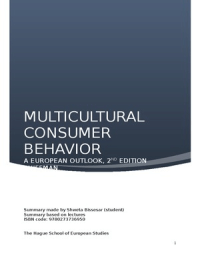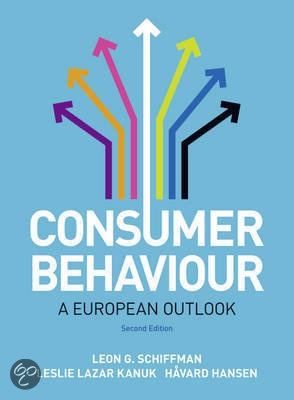MULTICULTURAL
CONSUMER
BEHAVIOR
A EUROPEAN OUTLOOK, 2ND EDITION
SHIFFMAN
Summary made by Shweta Bissesar (student)
Summary based on lectures
ISBN code: 9780273736950
The Hague School of European Studies
1
,The Hague University of Advanced Sciences
CONTENTS
Chapter 1 2
Chapter 4 4
Chapter 7 1
Chapter 8 4
Chapter 14 1
Chapter 15 4
2
, Chapter 1
Consumer behavior
The behavior that consumers display in searching for, purchasing, using, evaluating, and
disposing of products and services that they expect will satisfy their needs.
Includes all the decisions a consumer makes when spending their time, money and effort
on consumption related items. The what, why, when, where, and how of consumer
purchases are examined in consumer behavior. It is not just individuals, but households,
families, and groups that influence the decisions we make.
Two Consumer Entities
Personal consumer: The individual who buys goods and services for his or her own use,
for household use, for the use of a family member, or for a friend. Is sometimes called the
end-user or ultimate consumer. This is you when you go to Best Buy to purchase a new
television for your home.
Organizational Consumer: A business, government agency, or other institution (profit or
nonprofit) that buys the goods, services, and/or equipment necessary for the organization
to function. The organizational consumer is buying for the organization or to re-sell to the
personal consumer.
Customer Profitability-Focused Marketing
Tracks costs and revenues of individual consumers. It categorizes them into four tiers of a
customer pyramid based on consumption behavior. Customers are segmented by their
profitability to the firm. With this method, marketers can offer higher-level services to their
platinum customers who are more valuable to the marketer, more likely to try new offerings, and
are often not price sensitive.
1. Platinum: heavy users who are not price sensitive and are willing to try new offerings
(loyal customer)
2. Lead: customers who actually cost the company money because they claim more
attention and spread negative word-of-mouth. Not profitable customers.
Societal Marketing Concept
The societal marketing concept was developed from the marketing concept. Marketers and
consumers are increasingly taking stock of what is good for themselves, their family, their country,
and the planet. Marketing looks for opportunities to provide products and services to help
consumers reach their goals while also making profitable decisions for their companies. Includes
principles such as consumers’ long-run best interest and good corporate citizenship
Development of the Marketing Concept
The marketing concept was developed over time through two other important business
orientations. The first one is the production orientation, which assumes that consumers are
mostly interested in product availability at low prices. The second is sales orientation which
focuses on profits through sales volume.
The Marketing Concept
The marketing concept is a consumer-oriented marketing philosophy, which means that
marketers only produce products they have first confirmed that consumers want it through
research. This research is called Consumer Research: The process and tools used to study
consumer behavior. All companies must continually conduct research to understand the needs
and priorities of their market segments.
3
, Implementing the marketing concept
Segmentation: Process of dividing the market into subsets of consumers with common
needs or characteristics. Consumer needs are shaped by the environment, culture,
education, and life experiences. Marketers perform segmentation by looking for groups
with common needs. Segmentation can be based on consumers’ demographics, product
usage, geography, lifestyle, and many other characteristics and needs.
Market Targeting: The selection of one or more of the segments identified for the
company to pursue. When a marketer chooses the segments that they will pursue, they
have chosen a target market. Selection of the correct target market is critical to success
of the product since the marketer has assumed that this group of consumers has a similar
need with respect to their product or service.
Positioning: Developing a distinct image for the product/service in the mind of the
consumer. Positioning is how the consumer thinks about a product versus the
competitor’s product. The positioning is ultimately in the mind of the consumer but the
marketer helps form the positioning through effective advertising and communication.
Strong positioning differentiates a product from the competition and clearly tells the
consumer how it will fulfill their needs better than other products on the market.
Successful positioning includes two key principles:
Communicating the benefits of the product rather than the product’s features
Communicating a unique selling proposition
The Marketing Mix: The marketing mix is one of the most important concepts in
marketing. It thoroughly describes the product and the tools the company offers to
consumers. The product includes the name, design, and features. The price includes
the list price, discounts, and payment methods. Place is how a company will distribute
their product and promotion is how they will let customers know about the product and
its benefits.
Customer Value, Satisfaction, Trust, and Retention
The goal of all marketers is to build and maintain successful relationships with their
consumers. This is essential for the company’s profits.
This occurs by offering a product which has benefits that the consumer values. In
addition, they see the value of those benefits as exceeding the cost of the product – the
cost in terms of money, time, and opportunity costs.
If a product delivers value, the company is likely to have a high level of customer
satisfaction. The individual’s perception of the performance of the product or service in
relation to his or her expectations is positive.
After customer satisfaction, consumers will trust the marketer and continue to purchase
the product. In addition, they will tell others about the product and speak highly of it when
asked or when reviewing the product online.
A company with strong customer relationships will be able to achieve a high level of
customer retention – their customers will not switch to the competitor or stop using their
product. The company will retain these customers over time and will be more profitable
due to these valuable loyal customers who buy more products, spread positive word-of-
mouth, are less price sensitive and pay less attention to competitor’s advertising.
4





